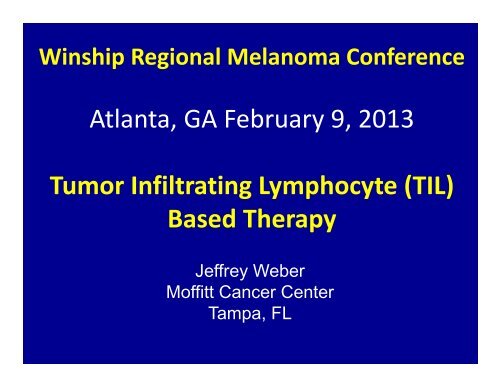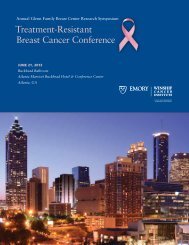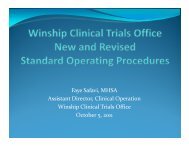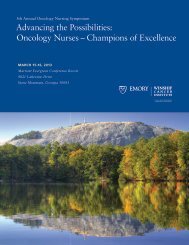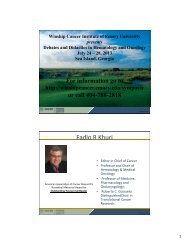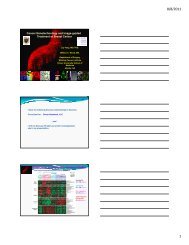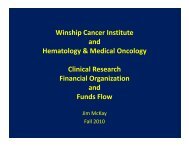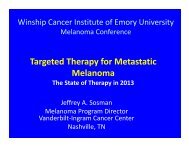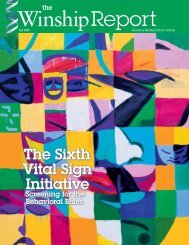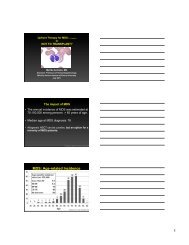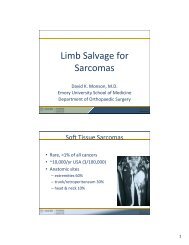Tumor-infiltrating lymphocyte (TIL) - Winship Cancer Institute of ...
Tumor-infiltrating lymphocyte (TIL) - Winship Cancer Institute of ...
Tumor-infiltrating lymphocyte (TIL) - Winship Cancer Institute of ...
You also want an ePaper? Increase the reach of your titles
YUMPU automatically turns print PDFs into web optimized ePapers that Google loves.
<strong>Winship</strong> Regional Melanoma ConferenceAtlanta, GA February 9, 2013<strong>Tumor</strong> Infiltrating Lymphocyte (<strong>TIL</strong>)Based TherapyJeffrey WeberM<strong>of</strong>fitt <strong>Cancer</strong> CenterTampa, FL
Disclosures• I have consulted for BMS, Genentech and GSK for AdBoards and DSMBs• I have received less than $10,000 per year from any<strong>of</strong> the above• I have served in the past on a Speaker’s Bureau forGenentech• My institution has received research funding fromBMS, Genentech and GSK
What Is Adoptive‐Cell Therapy?• T cells are isolated from tumor<strong>infiltrating</strong><strong>lymphocyte</strong>s orperipheral blood• Ex vivo enrichment and expansion<strong>of</strong> antigenspecificeffector T cells utilizing– IL‐2, anti‐CD3, feedercells, and/or antigen‐pulsedDCsAdoptivetransferintopatientT cellsisolatedfrompatientIn vitroexpansionandactivation• T cells are reintroduced back to thepatientYee C. 2009 ASCO Educational Book. Alexandria, VA:American Society <strong>of</strong> Clinical Oncology. 2009;511‐515.
<strong>Tumor</strong> Infiltrating Lymphocyte(<strong>TIL</strong>) Therapy for melanoma• Adoptive cell therapy with <strong>TIL</strong> was developed in the 1980sbased on murine models at the NCI• Minced tumors were incubated with IL-2 ex vivo and it wasfound that over time the <strong>infiltrating</strong> <strong>lymphocyte</strong>s grew outand cleared the tumor monolayer• The likelihood that cells would grow out was high (90%) inmelanoma, much less in other tumors• The cells were CD8 predominant, but occasionally a CD4+culture would grow• It took 4-5 weeks to expand the cells to 10 11 , and expansionwas performed in two stages:– Pre-expansion with just IL-2, then selection <strong>of</strong> reactive cells, and– Rapid expansion over 2 weeks with allo feeders and anti CD3
<strong>TIL</strong> cultures set-up n = 568Immediately or from previously cryopreserved sample<strong>TIL</strong> grew?Y = 551Record <strong>of</strong> co-culture assay ?At any time prior to May 31 st , 2008NY89 <strong>Tumor</strong>s censored(<strong>TIL</strong> frozen without testing)462 <strong>Tumor</strong>s AnalyzedJin, J et al J Immunother 2012
ResultsSource <strong>of</strong> specimenSource <strong>of</strong> SpecimenSpecimen No. <strong>of</strong> tumors Percent positive P2ALL 462 58%Lymph node 152 50% 0.13Subcutaneous 190 54% 0.15Intraperitoneal 14 64% 0.79Liver 17 64% 0.8Lung 50 68% 0.18Bowel 13 54% 0.78• Overall 58% <strong>of</strong> the 462 tumors were able to generate reactive<strong>TIL</strong>.• No significant differences between the sites <strong>of</strong> resection and theability to generate <strong>TIL</strong>.Jin, J et al J Immunother 2012
ResultsImpact <strong>of</strong> Prior Therapy within 3 months <strong>of</strong> harvestImpact <strong>of</strong> Prior Systemic TherapyTherapy No. <strong>of</strong> tumors Percent positive PSystemic therapy within 3 months <strong>of</strong> resection for <strong>TIL</strong>IFNα-2b 3 100% 0.37Chemotherapy 11 45% 0.27Interleukin-2 79 70% 0.012Vaccine 7 42% 0.45Anti-CTLA4 antibody 1 67% 1.0Adoptive Cell Therapy 4 25% 0.31• IL‐2 administered within 3 months <strong>of</strong> <strong>TIL</strong> harvest resulted in a significantimprovement in the ability to generate tumor reactive <strong>TIL</strong> (70%p=0.012).Jin, J et al J Immunother 2012
Rapid Expansion <strong>of</strong> <strong>TIL</strong> forAdoptive Cell Therapy30-60 bags required!
APre-REPPerforin38.7CD8Perforin PerforinIL-2+4-1BB62.5CD8IL-245.4CD8BHernandez-Chacon et al. 2011 J ImmunotherCD8+Perf+ T-cell frequency (%)10090 P< 0.000180706050403020100Pre-REP IL-2 IL-2+41BBCDPre-REPCD8+GB+ T-cell frequency (%)1009080706050403020100P= 0.0077Pre-REP IL-2 IL-2+41BB
Is adoptive T cell therapy a promisingmelanoma therapy?• First <strong>TIL</strong> human clinical experience at NCI showed 11/20responses, but mostly PRs, mostly short lived responses, but inpreviously treated, bulky tumor; median OS< 12 mo• Trafficking experiments showed minimal tumor tropism, andtagging experiments showed rapid turnover• Subsequently, 29/86 patients treated with <strong>TIL</strong> + high dose IL‐2had a response; 85% got > 10 11 cells, no differences seen withprior IL‐2 or use <strong>of</strong> cytoxan• Large numbers <strong>of</strong> direct intra‐lesional <strong>TIL</strong> were not useful; whywere these non‐selected T cells not successful?• Response correlated with young <strong>TIL</strong>, and tumor specificityRosenberg et al, NEJM 1988, JNCI 1994
Lympho‐depletion: important role foradoptive T cell transfer• The use <strong>of</strong> non‐myeloablative chemotherapyprior to adoptive transfer <strong>of</strong> T cells in murinemodels allowed, in one maneuver, theelimination <strong>of</strong> T regulatory cells, the skewing<strong>of</strong> the T cell repertoire, and the promotion <strong>of</strong>T cell memory by eliminating sinks forimportant cytokines like IL‐7 and IL‐15. Wouldlymphoid depletion prior to T cell adoptivetransfer prove useful?
Lymphoid depletion and ACT• Of 35 patients who failed high dose IL‐2 and received<strong>TIL</strong> after cytoxan+fludarabine preparative treatment toinduce lymphoid depletion, there was a 51% ORR, withmedian duration <strong>of</strong> response 12 months, with 3 CRs, 15PRs <strong>of</strong> 35• Subsequently, 43 patients had a similar preparativeregimen and different <strong>TIL</strong> growth technique: 49% ORRachieved• 25 additional patients each received the abovepreparative regimen, and either 2 or 12 cGy <strong>of</strong> TBI inaddition to chemotherapy; 54% and 72% ORR achievedwith only one treatment‐related death; most were priorhigh dose IL‐2 failuresDudley et al JCO 2005, 2008
Efficacy <strong>of</strong> <strong>TIL</strong> with lymphodepletion regimensRosenberg, S.A. et al; Clin Can Res 2011
Updated experience with <strong>TIL</strong>:the Surgery Branch NCIRosenberg, S.A. et al; Clin Can Res 2011
Survival by Prior Therapy In NCI‐SB“Selected” <strong>TIL</strong> ACT Trials•Progression on prior anti-CTLA4 does not preclude durable response•MD Anderson data: prior immunotherapy correlated with increased success for <strong>TIL</strong>generation Rosenberg, S.A. et al; Clin Can Res 2011
Clinical images after adoptive T celltherapyRosenberg, SA and Dudley, M Curr Opin Immunol 2009
Adoptive cell therapy after lymphodepletion: increasedtelomere length in respondersDudley, M. E. et al. J Clin Oncol; 26:5233-5239 2008Copyright © American Society <strong>of</strong> Clinical Oncology
Other factors associated withoutcome with <strong>TIL</strong>Rosenberg, S.A. et al; Clin Can Res 2011
Waterfall plot <strong>of</strong> percentage change in tumor burden in all treated patients (n = 31):MD Anderson experienceRadvanyi L G et al. Clin <strong>Cancer</strong> Res 2012;18:6758-6770©2012 by American Association for <strong>Cancer</strong> Research
Comparison <strong>of</strong> total cells infused and major T-cell subsets in the infused <strong>TIL</strong> product betweenresponders and nonresponders: MD Anderson experinceRadvanyi L G et al. Clin <strong>Cancer</strong> Res 2012;18:6758-6770©2012 by American Association for <strong>Cancer</strong> Research
Comparison <strong>of</strong> PD-1, BTLA, and TIM-3 on CD8+ <strong>TIL</strong> in responders and nonresponders.Radvanyi L G et al. Clin <strong>Cancer</strong> Res 2012;18:6758-6770
Other <strong>TIL</strong> trials: Low dose IL‐2 and“Young <strong>TIL</strong>”• Ellebaek et al in J Trans Med 10:1 169 2012 treated 6patients with lymphodepletion, then <strong>TIL</strong> followed bylow dose IL2• 2 CR (30+, 10+ mos), 2 SD, 2 PD noted• Response associated with tumor reactive <strong>TIL</strong>• Besser et al in Clin Can Res 16: 2646 2010reported on 20 patients treated with unselected“young” <strong>TIL</strong>• 2 CR (18+, 4+), 8PR, 4 SD = 50% ORR• 90% success rate at treating patients with <strong>TIL</strong>• All responders had pre‐REP <strong>TIL</strong> by day 20
Outcome is associated with number <strong>of</strong> infused CD8 T cells:Danish experienceMarco Donia, advance online publication27 September 2012. doi:10.1038/jid.2012.336
PD-1 is predominantly expressed by tumor-<strong>infiltrating</strong> T cellscompared with peripheral blood T cells.Ahmadzadeh M et al. Blood 2009;114:1537-1544©2009 by American Society <strong>of</strong> Hematology
TcR transduced T cells for adoptive immunotherapy <strong>of</strong> cancerRosenberg, SA et al Nature Reviews <strong>Cancer</strong> 2008
Chimeric TcR transduced T cells for CLLPorter, DL et al N Engl J Med. 2011 August 25; 365(8): 725–733.
PD effect <strong>of</strong> adoptively transferred TcRtransduced cells: cytokine levelsPorter, DL et al N Engl J Med. 2011 August 25; 365(8): 725–733.
Combined antitumor activity <strong>of</strong> TCR engineered adoptive cell adoptive cell transfer (ACT)immunotherapy and vemurafenib in the pmel-1 model.Koya R C et al. <strong>Cancer</strong> Res 2012;72:3928-3937©2012 by American Association for <strong>Cancer</strong> Research
Conclusions• <strong>TIL</strong> are a promising therapy for stage IV melanoma, andbear testing in a randomized trial as second or thirdline therapy• Pre‐treatment with ipilimumab may augment thenumber and yield <strong>of</strong> <strong>TIL</strong>• Post‐transfer therapy with targeted drugs mayaugment the ability <strong>of</strong> <strong>TIL</strong> to mediate regression <strong>of</strong>established tumor• TcR transduced <strong>TIL</strong> or PBMC can be very potenteffectors but represent a highly focused therapy towhich resistance may easily develop• <strong>TIL</strong> treated with anti CD137, and followed with PD‐1antibody may augment the yield, proliferation andactivity <strong>of</strong> cells after adoptive transfer
Acknowledgements• Bin Yu• WenShi Wang• Jay Alvarez• Ibrahim Younos• Amod Sarnaik• Erica Royster• Jim Mulé• Shari Pilon-Thomas


